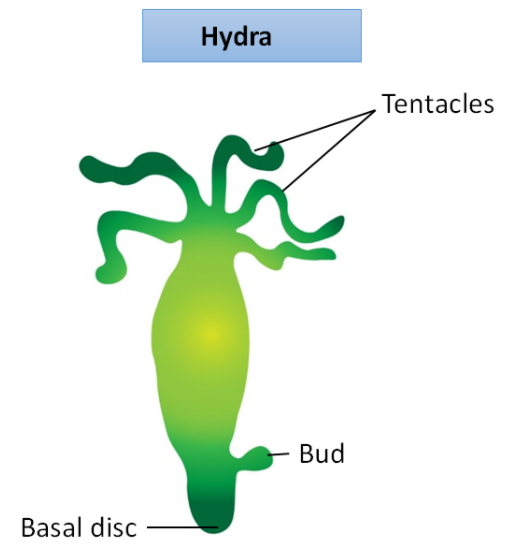
The locomotory organs of Hydra are
(a)Tentacles
(b)Tentacles and basal disc
(c)Hypostome
(d)None of the above
Answer
502.2k+ views
Hint: These structures are hollow and elongated. They are used to catch prey as well. It has nematocysts present on it. It can also climb by attaching and releasing by the contracting mechanisms.
Complete answer:
The Hydra is substratum by the basal disc and usually stands erect but moves for hunting. It has several methods of locomotion. They move with the help of the glutinant nematocysts by bending down and attaching the tentacles to the ground. It now releases and removes the basal disc (or the foot) to a new spot or location and again stands up by its tentacles. This type of locomotion is known as walking or looping, thus it can move several inches a day.
It can even walk inverted by using the tentacles as legs or may glide by dragging the basal disc that has the cells of which have the ability to throw out pseudopodia like an Amoeba. Hydra can secrete a bubble of gas by the ectodermal cells of the basal disc. By the hydrostatic action of the gas bubble, it can float on the surface of the water and is passively carried by water current or wind below.
So, the correct answer is ‘tentacles and basal disc’.
Note: -Fixation with the help of the basal disc is affected by the mucus-secreting gland cells in the epidermis and the glutinant nematocysts with sticky tentacles. Hydra has a bassel- shaped body and tentacles contain a different type of stinging cells called nematocysts.
-The body of Hydra bends over and makes a new place of attachment with the foot, this phenomenon is known as somersaulting.

Complete answer:
The Hydra is substratum by the basal disc and usually stands erect but moves for hunting. It has several methods of locomotion. They move with the help of the glutinant nematocysts by bending down and attaching the tentacles to the ground. It now releases and removes the basal disc (or the foot) to a new spot or location and again stands up by its tentacles. This type of locomotion is known as walking or looping, thus it can move several inches a day.
It can even walk inverted by using the tentacles as legs or may glide by dragging the basal disc that has the cells of which have the ability to throw out pseudopodia like an Amoeba. Hydra can secrete a bubble of gas by the ectodermal cells of the basal disc. By the hydrostatic action of the gas bubble, it can float on the surface of the water and is passively carried by water current or wind below.
So, the correct answer is ‘tentacles and basal disc’.
Note: -Fixation with the help of the basal disc is affected by the mucus-secreting gland cells in the epidermis and the glutinant nematocysts with sticky tentacles. Hydra has a bassel- shaped body and tentacles contain a different type of stinging cells called nematocysts.
-The body of Hydra bends over and makes a new place of attachment with the foot, this phenomenon is known as somersaulting.

Recently Updated Pages
Master Class 11 Economics: Engaging Questions & Answers for Success

Master Class 11 Business Studies: Engaging Questions & Answers for Success

Master Class 11 Accountancy: Engaging Questions & Answers for Success

Master Class 11 English: Engaging Questions & Answers for Success

Master Class 11 Computer Science: Engaging Questions & Answers for Success

Master Class 11 Maths: Engaging Questions & Answers for Success

Trending doubts
Which one is a true fish A Jellyfish B Starfish C Dogfish class 11 biology CBSE

State and prove Bernoullis theorem class 11 physics CBSE

1 ton equals to A 100 kg B 1000 kg C 10 kg D 10000 class 11 physics CBSE

In which part of the body the blood is purified oxygenation class 11 biology CBSE

One Metric ton is equal to kg A 10000 B 1000 C 100 class 11 physics CBSE

Difference Between Prokaryotic Cells and Eukaryotic Cells




